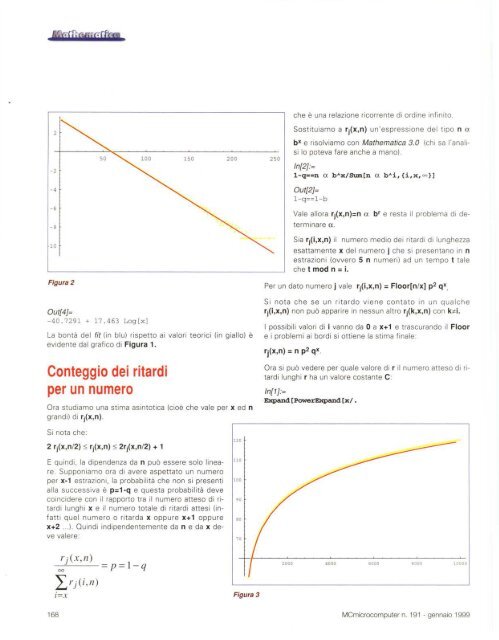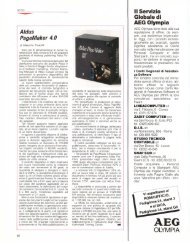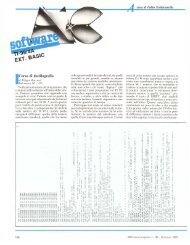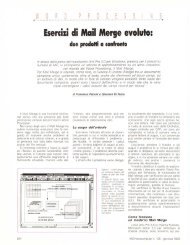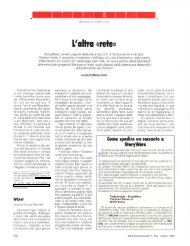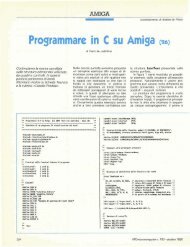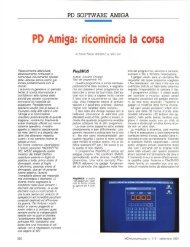Il massimo ritardo medio dei numeri del Lotto - digiTANTO.it
Il massimo ritardo medio dei numeri del Lotto - digiTANTO.it
Il massimo ritardo medio dei numeri del Lotto - digiTANTO.it
Create successful ePaper yourself
Turn your PDF publications into a flip-book with our unique Google optimized e-Paper software.
2<br />
-2<br />
-4<br />
-6<br />
-8<br />
10<br />
Figura 2<br />
Out[4]=<br />
-40.7291 + 17.463 Log[x]<br />
La bontà <strong>del</strong> f<strong>it</strong> (in blu) rispetto ai valori teorici (in giallo) è<br />
evidente dal grafico di Figura 1.<br />
Conteggio <strong>dei</strong> r<strong>it</strong>ardi<br />
per un numero<br />
Ora studiamo una stima asintotica (cioè che vale per x ed n<br />
grandi) di rj(x,n).<br />
Si nota che:<br />
2 rj(x,n/2) ~ rj(x,n) ~ 2rj(x,n/2) + 1<br />
E quindi, la dipendenza da n può essere solo lineare.<br />
Supponiamo ora di avere aspettato un numero<br />
per x-1 estrazioni, la probabil<strong>it</strong>à che non si presenti<br />
alla successiva è p=1-q e questa probabil<strong>it</strong>à deve<br />
coincidere con il rapporto tra il numero atteso di r<strong>it</strong>ardi<br />
lunghi x e il numero totale di r<strong>it</strong>ardi attesi (infatti<br />
quel numero o r<strong>it</strong>arda x oppure x+1 oppure<br />
x+2 ...). Quindi indipendentemente da n e da x deve<br />
valere:<br />
rj·(x,n)<br />
-oo---=p=l-q<br />
168<br />
Lrj(i,n)<br />
I=X<br />
120<br />
110<br />
100<br />
90<br />
80<br />
70<br />
Figura 3<br />
che è una relazione ricorrente di ordine infin<strong>it</strong>o.<br />
Sost<strong>it</strong>uiamo a rj(x,n) un'espressione <strong>del</strong> tipo n a<br />
b X e risolviamo con Mathematica 3.0 (chi sa l'analisi<br />
lo poteva fare anche a mano).<br />
In[2]:=<br />
l-q==n a bAx/SUm[n a bAi,{i,x,=}]<br />
Out[2]=<br />
1-q==1-b<br />
Vale allora rj(x,n)=n a b r e resta il problema di de-<br />
terminare a.<br />
Sia rj(i,x,n) il numero <strong>medio</strong> <strong>dei</strong> r<strong>it</strong>ardi di lunghezza<br />
esattamente x <strong>del</strong> numero j che si presentano in n<br />
estrazioni (ovvero 5 n <strong>numeri</strong>) ad un tempo t tale<br />
che t mod n = i.<br />
Per un dato numero j vale rj(i,x,n) = Floor[n/x) p2 qX.<br />
Si nota che se un <strong>r<strong>it</strong>ardo</strong> viene contato in un qualche<br />
rj(i,x,n) non può apparire in nessun altro rj(k,x,n) con k;éi.<br />
I possibili valori di i vanno da O a x+ 1 e trascurando il Floor<br />
e i problemi ai bordi si ottiene la stima finale:<br />
Ora si può vedere per quale valore di r il numero atteso di r<strong>it</strong>ardi<br />
lunghi r ha un valore costante C:<br />
In[1]:=<br />
Expand [PowerExpand [x/ •<br />
MCmicrocomputer n. 191 - gennaio 1999


